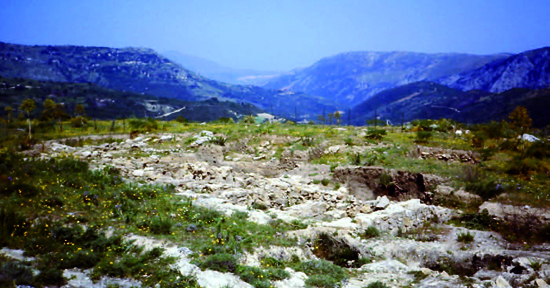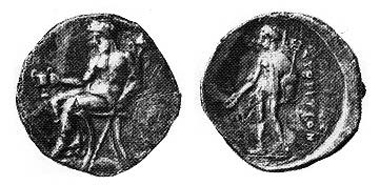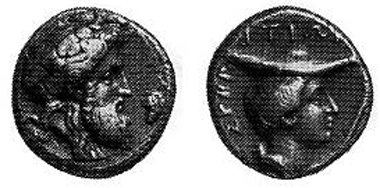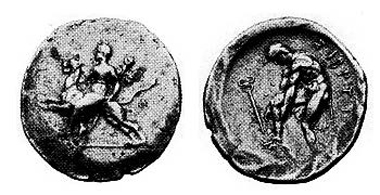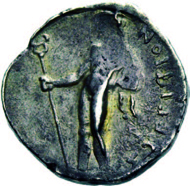by Burkhard Traeger
from Sammler-Merkur no. 18
by courtesy of Hanseatische Münzenhandlung Bremen
Located on the back and the terraced slopes of the hills of Kefala, west of the village of Thrónos – 30 or so kilometers away from Réthymnon – at the outskirts of the Amarai Valley are the remains of the ancient polis of Sybrita. The city at the south outskirts of Mount Ida whose name, ‘sweet water’, refers to the springs nearby, is not much known so far.
Ruin from the Minoan period.
The most recent archaeological excavations have found evidence that Kefala Hill, 618 meters high, has been occupied as early as late Minoan times (Vassilákis 133). The exposed location of Sybrita at the ancient trade routes between north and south as well as the east and west of Crete, which allowed the Amarí Basin to be controlled, made Sybrita become a flourishing commercial city in the Hellenistic era (Spanakis 743 et seq.). Likewise part of the polis was the port Soulia at the Libyan Sea (today Ágia Galíni) (Lauffer 644).
Le Rider IX, 7; specimen Traeger Coll., Künker 136, 2008, 371; 24 mm; 11.26 g.
Since the middle of the 4th cent. B. C., Sybrita maintained close relations with Górtyna, evidenced by treaties of alliance, on the one hand, and by the coinage of Sybrita between 360 and 330 B. C., when the staters of Górtyna with the depiction of Europe on the holy plane tree and Zeus in the guise of a bull were adopted (Stefanákis 11), on the other hand.
Le Rider IX, 8; specimen Sammler-Merkur 17, 59; 28 mm; 11.24 g.
The distinctive feature of the coins of Górtyna is the Archaic inscription placed in the branches of the plane tree which states the place where the coins were produced.
At the end of the 3rd cent. B. C., Sybrita was member of the koinon of Crete under the leadership of Górtyna and was an ally of Macedonia. In 204 B. C., Sybrita was one the cities visited by the representative of Philipp V of Macedon, Perdikkas (Chaniotis 39). A treaty of alliance with Górtyna dating to the late 3rd or early 2nd century B. C. written on a pillar of the Pythion of Górtyna (Chaniotis 267-270) testifies that Sybrita was still influenced by Górtyna at that time. In 183 B. C., Sybrita belonged to the 30 cities signing a treaty of alliance with Euemes II, close friend of the Romans (Chaniotis 43).
Foundation walls from Roman times.
Remains of Sybrita’s ancient buildings, covering a period of time from late Minoan times to the Roman dominion over the island, can be seen on Kefala Hill that can be accessed via a arduous path, after a roughly 15 minutes-walk starting from the village of Thrónos. These remains have been discovered during Greek-Italian excavations which are still going on and are now conducted by a team of Swedish archaeologists. Numerous foundations walls of fortifications and edifices as well as cisterns have been unearthed by now. While the ruins of the Minoan era are located at the crest of the hill, the houses from Hellenistic and Roman times cover the lower parts eastward.
View from the crest of Kefalas Hill to Mount Psolorítis.
Amazing is the vista from the archaeological site across the Amarí Basin to Mount Kédros in the south and to the Psilorítis Mountains with the 2,456 m high peak Timios Stavrós located in the east.
Sybrita is well-known primarily thanks to its coins dating to the late 4th and early 3rd cent. B. c.
These four staters, minted in that very period of time, are characterized by the magnificent artistic quality of their depictions and testify that the inhabitants of Sybrita had managed to find themselves a highly talented artist whose works on Crete are without parallel (Hurter in Auktion Leu 76, 1999, 138).
Svoronos 314.1, pl. 30.12; Le Rider XXVII, 20; specimen SNG Lockett 2608; MM 66; 1984, 219; 26 mm, 10.78 g.
On one of the staters bearded Dionysos is depicted in frontal view, sitting on a chair, holding the thyrsos stick in his left and a kantharos in his right as symbol of inebriety. The reverse shows Hermes, standing in an upright position, as wayfarer wearing the petasos and the chlamys, holding the kerykeion in his left and a bowl in his right hand. The inscription reads SYBRITION.
Svoronos 315.4, pl. 30.16; specimen Leu 77, 2000, 233; 21 mm; 10.79 g.
Another of the polis’ staters depicts the main deities, their heads to be precise, in a delicate style and in high relief, Dionysos with a beard and a wreath made of wine leaves with a dove in front, Hermes with petasos, SYBRITION behind and a kerykeion in front.
Svoronos 315.6, pl. 30.18; Le Rider IX, 11; specimen Leu 13, 1975, 183; 25 mm; 11.45 g.
On probably the most interesting silver coins from the island of Crete from the beginning of the 3rd cent. B. C., Sybrita once again depicts Dionysos, this time being at a young age and beardless, riding a panther, and therewith referring to a well-known and popular motif of Hellenistic mosaics, like the one from Pella dating to the late 4th cent. B. C., appearing on Attic and Campanian red-figure vessels or the famous mosaic from the House of the Masks from Delos (Stefanákis 11, LIMC III, sv. Dionysos 430-434). On the reverse of the coin, naked Hermes is shown, standing slightly crouched, binding his sandal on his foot he has put on a rock; this iconography harks back to the famous work of Lysippos from 330/20 B. C., that has come down to us in later Roman copies (LIMC V, s.v. Hermes 958-960).
Svoronos 315.5, pl. 30.17; Le Rider IX, 10; specimen Sammler-Merkur; 26 mm; 11,30 g.
On the fourth stater of this series, we see the head of juvenile Dionysos with an ivy wreath and long hair turned to the right, a wine bunch behind, on the obverse, while the reverse is decorated with pensive Hermes, standing to the left. A petasos can be seen at the back of his head, a chlamys around the armpits with both ends slung around the left arm; in the right, Hermes holds a long kerykeion. The origin of the coin, SYBRITION, is stated at the right-hand side. A comprehensive work (Naster 35 et seq.) has already pointed out that in the description the coins of the polis of Sybrita were once written with an omicron, another time with an omega, although this mustn’t be overemphasized and doesn’t diminish the appeal of these four outstanding coins at all.
Some bronzes dating to the second half of the 3rd cent. B. C. are known from Sybrita as well, but they don’t match up to the artistic verve of the earlier silver specimens.
Bibliographic references
Chaniotis, Angelos: Die Verträge zwischen Kretischen Poleis in der hellenistischen Zeit. Stuttgart 1996
Lauffer, S.: Griechenland, Lexikon der historischen Stätten. München 1989
Le Rider, G.: Monnaies crétoises du Ve au 1er siècle av. J.-C. Paris 1966
Naster, Paul: La légende SIBRYTIOI sur des monnaies de Sybrita, Revue belge de Numismatique t. XCIII, 35-40. Bruxelles 1947
Svoronos, J.-N.: Numismatique de la Crète ancienne. Macon 1890
Vassilákis, A. Sp.: Kreta, Geographie – Geschichte – Museen – Archäologische Stätten und Monumente. Athen o. J.
Spanakis, S. G.: Póleis kai choriá tis krítis sto pérasma ton aiónon, Tómos B. Herakleío 1991
Stefanákis, M. I.: Ta nomismata ton archaíon póleon tis Krítis, Chania 2000
Sammler-Merkur is published by the Hanseatische Münzenhandlung Bremen as sales catalog and numismatic journal. That company is a coin dealer in the traditional sense and no website of its own.
The shop is located in Fedelhören 8, D-28203 Bremen-Ostertor.
phone: (0421) 32 10 94
fax: (0421) 32 68 72
You can also make contact via email.



